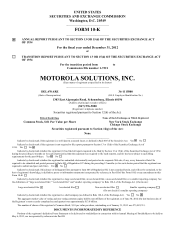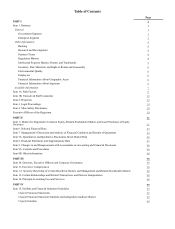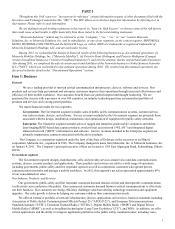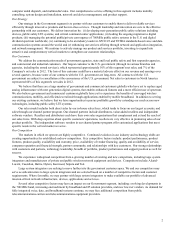Motorola 2012 Annual Report Download - page 14
Download and view the complete annual report
Please find page 14 of the 2012 Motorola annual report below. You can navigate through the pages in the report by either clicking on the pages listed below, or by using the keyword search tool below to find specific information within the annual report.6
We actively participate in the development of standards for interoperable, mission-critical digital two-way radio systems.
Our patents are used in various standards including APCO P-25, ETSI, TETRA, DMR and dPMR. We offer licenses to those
patents on fair, reasonable and non-discriminatory terms.
Notwithstanding the transfer of patents to Motorola Mobility, the expiration of certain patents and the potential for
increased competition for some of our products in the future, we believe that our patent portfolio will continue to provide us
with a competitive advantage in our core product areas as well as provide leverage for future technologies. Furthermore, we
believe we are not dependent upon a single patent or a few patents. Our success depends more upon our extensive know-how,
innovative culture, technical leadership and marketing abilities. We do not rely primarily on patents or other intellectual
property rights to protect or establish our market position; however, we will enforce our intellectual property rights in certain
technologies when attempts to negotiate mutually agreeable licenses are not successful.
Patents and Trademarks
We seek to obtain patents and trademarks to protect our proprietary position whenever possible and practical. As of
December 31, 2012, we owned approximately 6,354 patents in the U.S. and in foreign countries. As of December 31, 2012, we
and our wholly owned subsidiaries had approximately 2,648 U.S. and foreign patent applications pending. These foreign
patents and patent applications are mostly counterparts of our U.S. patents. During 2012, we and our wholly owned subsidiaries
were granted 340 U.S. patents and 372 patents in other countries.
We no longer own certain logos and other trademarks, trade names and service marks, including MOTOROLA, MOTO,
MOTOROLA SOLUTIONS and the Stylized M logo and all derivatives and formatives thereof (“Motorola Marks”) and we
license the Motorola Marks from Motorola Mobility, which is currently owned by Google.
Inventory, Raw Materials, Right of Return and Seasonality
Our practice is to carry reasonable amounts of inventory to meet customers’ delivery requirements in a manner consistent
with industry standards. We provide custom products which require the stocking of inventories and large varieties of piece parts
and replacement parts in order to meet delivery and warranty requirements. To the extent suppliers’ product life cycles are
shorter than ours, stocking of lifetime buy inventories is required to meet long-term warranty and contractual requirements. In
addition, replacement parts are stocked for delivery on customer demand within a short delivery cycle.
Availability of materials and components required is generally dependable; however, fluctuations in supply and market
demand could cause selective shortages and affect our results of operations. We currently procure certain materials and
components from single-source vendors. A material disruption from a single-source vendor may have a material adverse impact
on our results of operations. If certain single-source suppliers were to become capacity constrained or insolvent, it could result
in a reduction or interruption in supplies or an increase in the price of supplies and adversely impact our financial results.
Natural gas, electricity and, to a lesser extent, oil are the primary sources of energy for our manufacturing operations.
Each of these resources is currently in adequate supply for our operations. In addition, the cost to operate our facilities and
freight costs are dependent on world oil prices. Labor is generally available in reasonable proximity to our manufacturing
facilities. Difficulties in obtaining any of the aforementioned resources or a significant cost increase could affect our financial
results.
Generally, our contracts do not include a right of return, other than for standard warranty provisions; however, certain
distributor partners within the commercial enterprise markets do maintain limited stock rotation rights. Due to buying patterns
in the markets we serve, sales tend to be somewhat higher in the fourth quarter.
Environmental Quality
During 2012, compliance with U.S. federal, state and local, and foreign laws regulating the discharge of materials into the
environment, or otherwise relating to the protection of the environment, did not have a material effect on our capital
expenditures, earnings or competitive position.
Employees
At December 31, 2012, we and our subsidiaries had approximately 22,000 employees, compared to 23,000 employees at
December 31, 2011.
Financial Information About Geographic Areas
The response to this section of Item 1 incorporates by reference Note 11, “Commitments and Contingencies” and Note 12,
“Information by Segment and Geographic Region” of Part II, Item 8: Financial Statements and Supplementary Data of this
document, the “Results of Operations—2012 Compared to 2011” and “Results of Operations—2011 Compared to 2010”
sections of Part II, “Item 7: Management’s Discussion and Analysis of Financial Condition and Results of Operations” and
“Item 1A: Risk Factors” of this document.
Financial Information About Segments
























